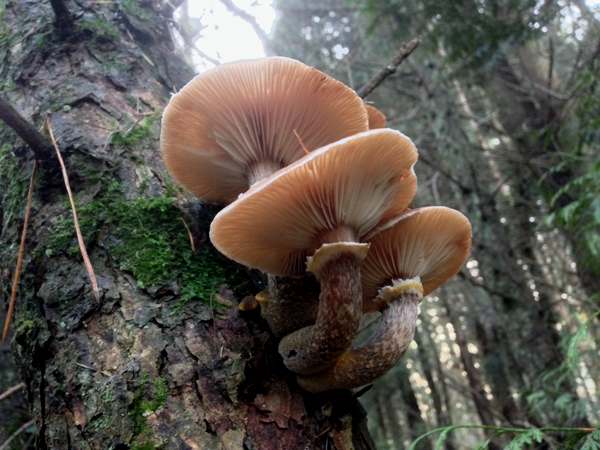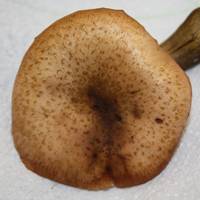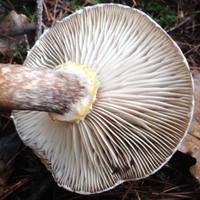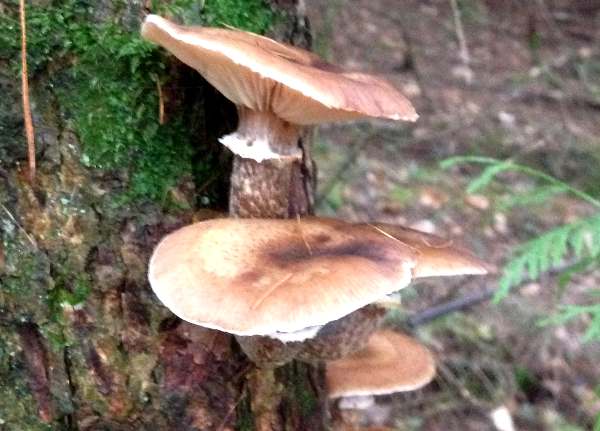Armillaria borealis Marxm. & Korhonen - Northern Honey Fungus
Phylum: Basidiomycota - Class: Agaricomycetes - Order: Agaricales - Family: Physalacriaceae
Distribution - Taxonomic History - Etymology - Identification - Toxicity - Reference Sources

There are many forms of Honey Fungus, and in the distant past they all shared the scientific name Armillaria mellea. Nowadays it is generally accepted that there are several distinct species, one of which, Armillaria borealis, was only recognised as recently as 1982.
Armillaria borealis has a very catholic taste for timber, appearing (generally quite high up) on a wide range of broadleaf and coniferous trees, including (as seen here) pines.
Distribution
This species is a very rare find in Britain and Ireland; it has been recorded most often in Scotland but there are several records from England and at least one from Ireland. Elsewhere in Europe it is most often seen in Finland and occurs occasionally in other northern countries at least as far south as France and the Netherlands. It seems likely that many finds go unrecorded, as it is easy to confuse this rare species for the much more common and widespread Honey Fungus Armillaria mellea.
Taxonomic history
This woodland mushroom was accepted as a separate species, Armillaria borealis, following a 1982 publication in France by German mycologist Helga Marxmüller and Finnish mycologist Kari Korhonen.
Etymology
The specific epithet borealis comes from the Greek noun boréas which means 'north wind'; Borealis means 'of the north', and indeed records show that Armillaria borealis is most common in northern parts of Europe.
Toxicity
Although all Armillaria species were for many years generally considered edible when thoroughly cooked, some members of the honey fungus group (including Armillaria mellea, the type species of this genus) that occur on hardwoods are considered by some to be suspect, as cases of poisoning have been linked to eating these fungi; this is most probably due to a small but significant proportion of people being adversely affected rather than a universal human reaction to these fungi. We therefore recommend that Armillaria borealis, which in any case is a rare species in Britain and therefore worthy of conservation, should not be collected for the pot.
Identification guide
 |
Cap2 to 8cm in diameter; orange-brown, sometimes with an olive tinge, and with a darker brown central area; hygrophanous, drying paler from margin; initially convex then flattening, often with a broad umbo; surface covered with small brown pointed scales. The cap flesh is whitish and firm. |
 |
GillsThe adnate or weakly decurrent gills are crowded and initially almost white, gradually becoming cream and then orange tinged with scattered brown rust-like spots at maturity. StemPalest at the apex; colour as cap below the ring, darkening as the fruitbody matures; 4.5 to 12cm long; slender, with a clavate base.tapering towards the apex. Surface with persistent yellowish woolly scales, largest near the ring and progressively smaller towards the base. There is a persistent thick but narrow ring, with a yellow edge/underside but no dark spots (see Armillaria ostoyae). Stems usually emerge from timber in small tufts. Stem flesh is whitish. |
BasidiaUsually four-spored, clavate, with basal clamps (unlike Armillaria mellea, whose basidia do not have basal clamps). SporesEllipsoidal, smooth, usually with guttules; 7.5-10 x 5-7µm; amyloid. Spore printVery pale cream. |
|
Odour/taste |
Slight 'mushroomy' odour; taste initially mild then gradually unpleasant. |
Habitat & Ecological role |
Parasitic (and later saprobic) on standing broadleaf and coniferous trees; also occasionally seen on dead stumps. Nearly always the fruitbodies appear well above ground level and often high up on the trunks particularly of birches. |
Season |
Late summer and autumn in Britain and Ireland. |
Similar species |
Armillaria mellea, commonly referred to as Honey Fungus, generally has a much chunkier persistent stem ring. Pholiota squarrosa grows low down on hardwood trees; it is generally similar in colour and covered in scales; it retains an in-rolled margin, the gills turn uniformly rusty-brown, and it has a radish-like smell and taste. |

Reference Sources
Flora Agaricina Neerlandica: Critical Monographs of Families of Agarics and Boleti occuring in the Netherlands Vol. 3, Tricholomataceae (Ed.: C.Bas, Th.W. Kuyper, M.E. Noordeloos & E.C. Vellinga)
Dictionary of the Fungi; Paul M. Kirk, Paul F. Cannon, David W. Minter and J. A. Stalpers; CABI, 2008
Taxonomic history and synonym information on these pages is drawn from many sources but in particular from the British Mycological Society's GB Checklist of Fungi.
Acknowledgements
This page includes pictures kindly contributed by Simon Harding.
Fascinated by Fungi. Back by popular demand, Pat O'Reilly's best-selling 450-page hardback book is available now. The latest second edition was republished with a sparkling new cover design in September 2022 by Coch-y-Bonddu Books. Full details and copies are available from the publisher's online bookshop...

